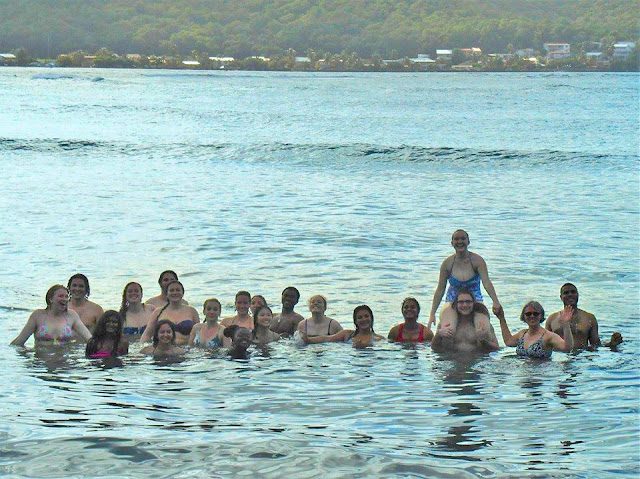 |
| Giants! |
 The carnival was
first celebrated in Martinique at Saint Pierre by the French Catholics in the
18° century. In the 17° and 18° century it was a celebration reserved for the
rich colonies, with elegant receptions in costume. Only after the abolition of
Slavery in 1848 was carnival actually opened to everyone and gained its characteristic
style. It became famous for its originality which is influenced by the former slaves’ adaptation of their own beliefs and
traditional instruments: tambourines, cha-cha, ti-bois…
The carnival was
first celebrated in Martinique at Saint Pierre by the French Catholics in the
18° century. In the 17° and 18° century it was a celebration reserved for the
rich colonies, with elegant receptions in costume. Only after the abolition of
Slavery in 1848 was carnival actually opened to everyone and gained its characteristic
style. It became famous for its originality which is influenced by the former slaves’ adaptation of their own beliefs and
traditional instruments: tambourines, cha-cha, ti-bois…
From 1848 to 1902
the Carnival of Saint Pierre was extremely famous in Martinique, despite the
fact that the celebrations at the time were overshadowed by the discrimination. In effect, one side of the colony was celebrating with masked
balls, private banquettes and luxurious costumes whilst the other side of the
island was occupied with celebrations of the vidés nègres. After the
catastrophe of Saint Pierre, the carnival festivities were halted for 2 years
in Martinique. When they started by up again, the Carnival relocated to Fort de
France.
In some
parts of the US, Mardi Gras is actually celebrated the day before Ash Wednesday.
“Fat Tuesday” is the last day people had to eat rich, fatty foods before the
strict Lenten fasts began the next day. Well, here they don’t just celebrate
Mardi Gras, they have Samedi Gras, Dimache Gras, Lundi Gras and Mardi Gras.
Each day has a different custom connected to it:
This is the
day the “Queens” of Carnaval are presented to their towns. Each town elects a “Queen”
a “mini-queen” and a “Queen Mother” and they take part in the parade as
royalty. Anyone can dress up in any costume they like on the Saturday.
Dimanche Gras:
The Sunday
before Ash Wednesday is when the king of Carnaval, Vaval, is presented. He is
usually a giant puppet or doll that takes the shape of a certain political
figure, or even an abstract figure that represents an idea or type of person.
Vaval will be symbolically burned at the end of the Carnival festivities on Ash
Wednesday. The Carnival queen sits beside Vaval during the parades. Again, this
is a free costume day and everyone dresses as they please.
Lundi Gras: Monday is a themed costume day! The festivities start early when a chosen member of the town runs through the streets waking everyone up to join him in the streets wearing their pajamas. A pajama parade ensues! The evening’s theme is burlesque weddings and them men dress as brides and the women as the men.
 |
| A different type of queen :) |
Lundi Gras: Monday is a themed costume day! The festivities start early when a chosen member of the town runs through the streets waking everyone up to join him in the streets wearing their pajamas. A pajama parade ensues! The evening’s theme is burlesque weddings and them men dress as brides and the women as the men.
 |
| Anna fraternizing with this fabulous devil! |
Mardi Gras:
Everyone
dresses like the devil and calls for the destruction of Vaval. In the
traditional Catholic calendar, this would be the last day of Carnival, but in
Martinique, the festivities continue through Wednesday, with the frenzy growing
each day!
Ash Wednesday:
All dressed in black and white, in mourning
for the death of Vaval, who is symbolically burnt on a bonfire at nightfall,
the inhabitants of the island are at the peak of Carnaval!
 |
| My host mom! |
Unfortunately,
Carnaval starts the week after we leave to go back to the US, so we won’t be
here to see the full spectacle, but we were able to see a parade at least!
Because it was a Sunday, Anna’s host sisters came and grabbed me and we went
downtown to watch the parade for about an hour. I wanted to see my host mom, in
her cute little bumblebee outfit. We were just about to leave without having
seen her when I spotted them in the distance. Perfect timing!
We left just
after that so we wouldn’t get stuck in the crowds. Since it was just about
sunset time, I had them drop me off at the hotel near my host mom’s house where
I swim in the mornings so I could catch the sunset… it was a good one I think…
what do you think? :)



































